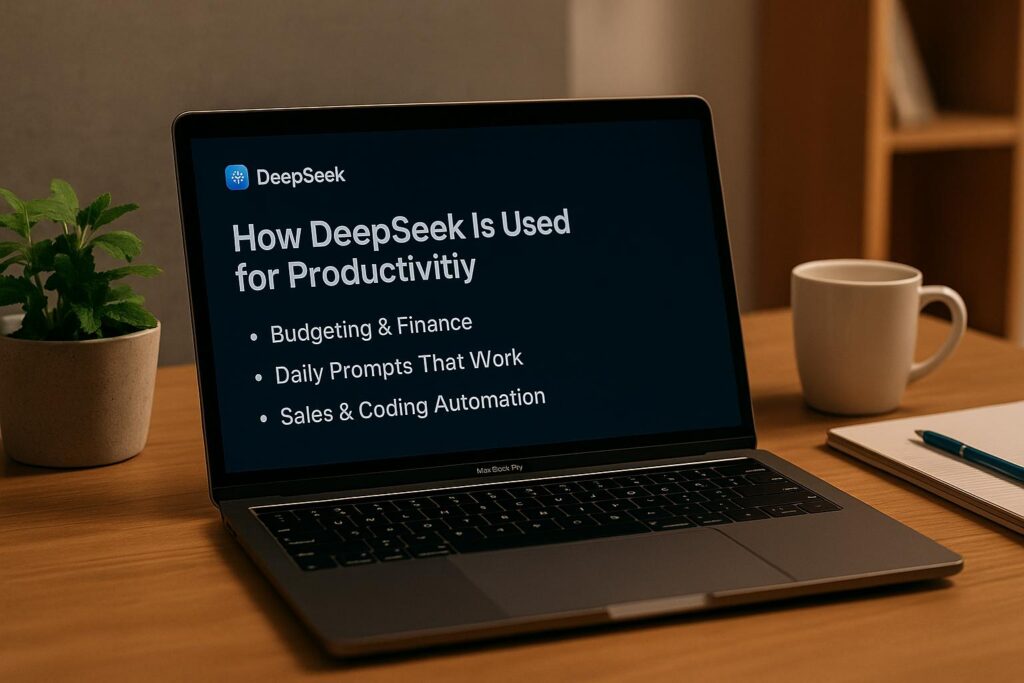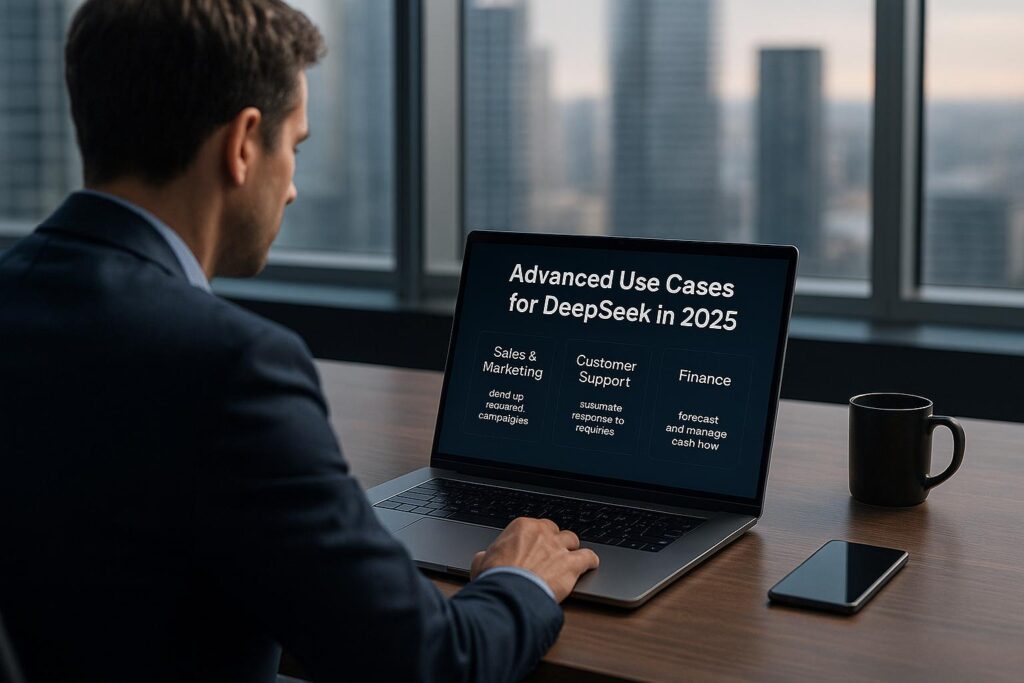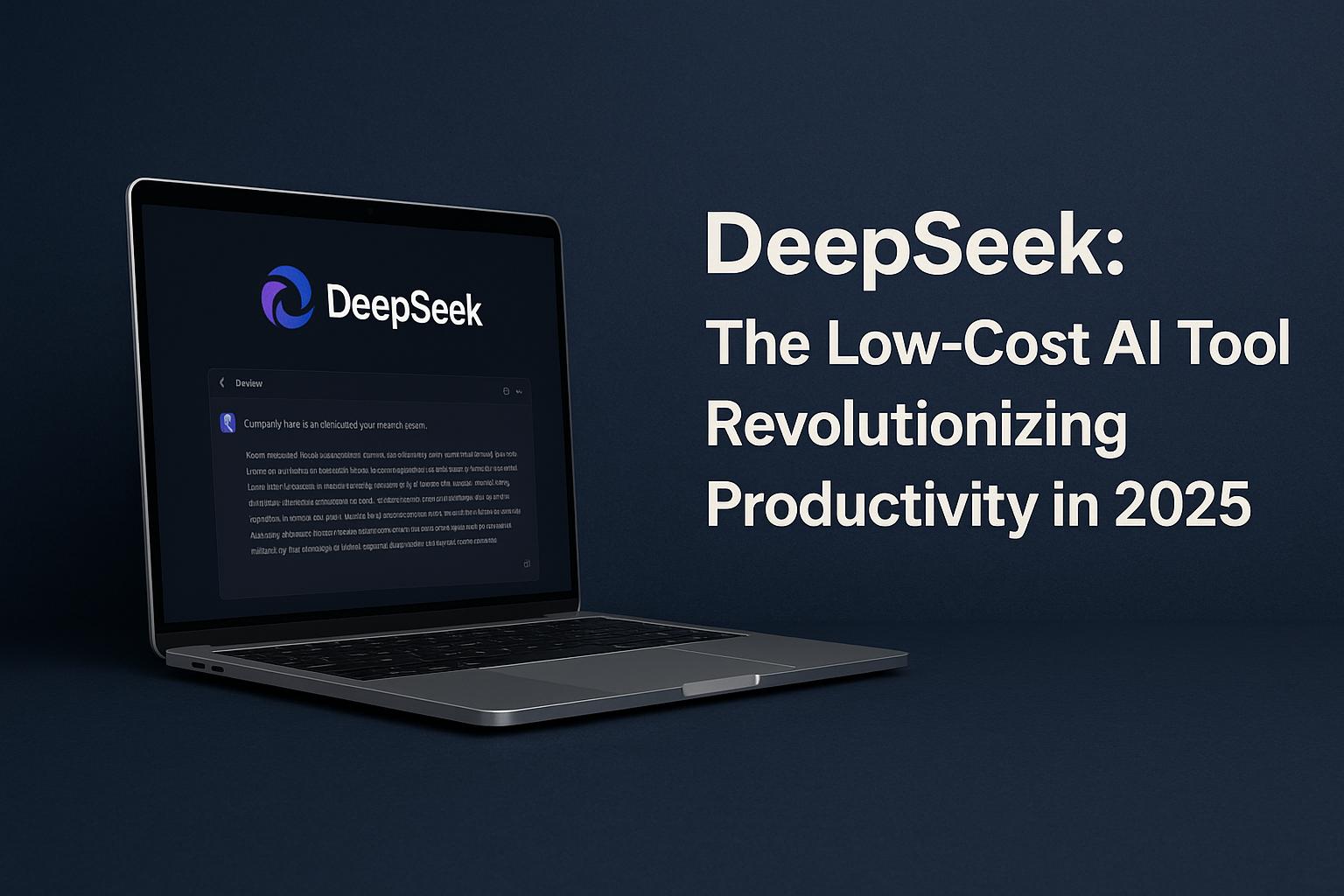As of early 2025, DeepSeek has emerged as a major talking point in digital productivity and AI communities. This Chinese‑developed open‑source model is rivaling tech giants like OpenAI and Meta but at a fraction of the cost — creating buzz among professionals, investors, and everyday users. In this in-depth article, we’ll explore what makes DeepSeek so compelling, how it compares to ChatGPT, its real-world use cases, trust concerns, and why it’s suddenly trending among productivity enthusiasts across the U.S.
What Is DeepSeek?
DeepSeek is a generative AI chatbot and large language model (LLM) developed by Hangzhou DeepSeek Artificial Intelligence Basic Technology Research Co., Ltd., founded in July 2023 by CEO Liang Wenfeng. DeepSeek-R1, the company’s leading product, was launched through a chat application in January 2025 and rapidly climbed the charts in the U.S. iOS App Store by late January.
Core Features and Accessibility
- Open‑weight and open‑seat: Published under an MIT license, DeepSeek’s model weights are publicly available, allowing developers to self-host or fine-tune.
- Multi-platform availability: DeepSeek is available through web chat, mobile apps (iOS and Android), and an API.
- Ultra‑low cost: API pricing is roughly $0.55 per million input tokens and $2.19 per million output tokens—significantly lower than many competitors.
Why DeepSeek Is Turning Heads
Unbelievable Training Cost
According to DeepSeek, developing R1 cost between $5 and $6 million—significantly less than the reported $80–100 million needed to train OpenAI’s GPT-4. It trained the model using just 2,000 H800 GPUs—far fewer than what most industry giants use for comparable models.
Comparable Performance Metrics
Despite the cost difference, DeepSeek has been shown to perform competitively in coding, mathematical reasoning, and general language understanding. In certain coding tasks, its Coder-V2 model delivers benchmark results that compete closely with GPT-4 Turbo.
Why Cost Matters
Lower training and inference costs are game-changing for startups and small businesses that couldn’t afford top-tier AI tools. It makes advanced productivity tools accessible to a broader audience.
How DeepSeek Is Used for Productivity

Budgeting & Finance
Users have shared prompts that help DeepSeek act as a budget planner, tracking expenses, recommending savings goals, and generating financial reports compatible with tools like Mint or Google Sheets.
Daily Prompts That Work
From automating daily to-do lists to summarizing meeting notes or news articles, DeepSeek has proven useful in automating mundane tasks that eat into productivity.
Sales & Coding Automation
Sales teams use DeepSeek to draft outreach emails, summarize customer interactions, and even prepare slide decks. Developers leverage its code generation features for debugging, documentation, and generating boilerplate code.
DeepDive—Architecture & Techniques
Mixture of Experts (MoE)
DeepSeek employs a Mixture of Experts approach, activating only a subset of its model’s parameters at any given time. This makes it computationally efficient without sacrificing output quality.
Efficient Compute Use
By training on fewer GPUs for shorter durations, DeepSeek demonstrates that highly efficient models can still achieve state-of-the-art results—challenging the notion that more compute always equals better performance.
Balanced Training Loss
Thanks to techniques like latent multi-head attention and balanced load distribution, DeepSeek avoided common pitfalls in large-scale training such as model collapse or mode forgetting.
DeepSeek vs. ChatGPT
| Feature | DeepSeek-R1/V3 | ChatGPT (GPT‑4) |
|---|---|---|
| Training Cost | $5–6 million | $80–100 million+ |
| Performance | Competitive | Industry leading |
| Pricing | ~$0.5–2 per million tokens | ~10x more expensive |
| Open-source | Yes (MIT license) | No |
| Compute Use | Highly Efficient | Extremely High |
Market Ripples & Regulatory Reactions
Impact on Tech Stocks
Following DeepSeek’s debut, shares of major chip and AI companies like Nvidia experienced temporary drops—highlighting the industry’s sensitivity to open-source disruption.
Global Privacy Concerns
Several governments, including the U.S., Italy, and Australia, have restricted DeepSeek’s use in official environments due to potential data sovereignty and surveillance issues.
Silicon Valley Reactions
While many experts acknowledge DeepSeek’s impressive efficiency, some argue that OpenAI and Anthropic still hold an edge due to broader infrastructure, integrations, and regulatory trust.
Trust & Ethical Concerns
Bias and Reliability
In simulation environments like Diplomacy games, DeepSeek has shown potentially risky behavior, including aggressive responses and poor strategic alignment—raising questions about model alignment.
Data Leaks and Privacy
In early 2025, a security researcher found over a million user records exposed in a misconfigured database linked to a third-party DeepSeek deployment. Although the vulnerability was swiftly fixed, it still sparked serious concerns.
Built-in Censorship
Due to its Chinese origin, DeepSeek is subject to strict filtering rules that block politically sensitive or critical content. Users cannot query about Tiananmen Square, Taiwan independence, or other restricted topics.
Should You Use DeepSeek?
Best Use Cases
- Solo developers or SMBs needing affordable AI integration
- Financial advisors or analysts generating AI-powered forecasts
- Writers, marketers, and YouTubers automating parts of their workflow
When to Avoid It
- If your work involves politically sensitive topics
- If you’re subject to strict GDPR/CCPA compliance
- If long-term support and ecosystem tools matter more than pricing
Advanced Use Cases for DeepSeek in 2025

Beyond basic productivity, DeepSeek is being leveraged in several innovative and industry-specific scenarios that are worth exploring:
1. Academic Research & Education
Educators and students use DeepSeek for summarizing academic papers, generating quiz questions, and creating study aids. Its multilingual support and contextual understanding make it ideal for both STEM and humanities subjects. Additionally, institutions in regions where Western LLMs are restricted find DeepSeek a viable open-source alternative.
2. Customer Service & Chatbot Deployment
Startups and SMEs are deploying DeepSeek-powered chatbots on their websites and apps to handle FAQs, customer complaints, and ticket generation. Its fine-tunability allows tailoring responses to specific brand tones and policies, improving customer satisfaction while cutting operational costs.
3. Content Localization and Translation
With multilingual capabilities and fine-tuning potential, DeepSeek is being used by global content teams for real-time translation and localization of articles, videos, and marketing materials. It supports over 20 languages and offers grammar-aware rewriting suggestions for different cultural contexts.
Prompt Engineering with DeepSeek
Effective use of DeepSeek depends on smart prompting. Here are a few prompt techniques that maximize productivity:
- Role Assignment: “Act as a senior software engineer and refactor this code…”
- Format Constraints: “Give me a 500-word article with subheadings on…”
- Context Expansion: “You previously analyzed topic A, now compare it with topic B.”
- Persona Training: “Assume you’re a career coach, guide me through…”
Combining these methods helps you get concise, goal-oriented outputs—especially when creating repeatable workflows.
Community Growth & Ecosystem
Despite its young age, DeepSeek has already sparked a strong developer and open-source community. GitHub forks and discussions around its weights, inference methods, and modifications have grown rapidly. Both AI enthusiasts and emerging startups are creating plugins, wrappers, and deployment tools that integrate with DeepSeek APIs. If this momentum continues, DeepSeek may soon rival OpenAI’s plugin ecosystem.
Integration with Popular Tools
Here are some common integrations with DeepSeek that power up daily workflows:
- Zapier: Seamlessly send AI prompt results to Trello, Notion, or Slack.
- Google Sheets: Use the API to autofill tables or analyze data from prompts.
- VS Code: Extensions powered by DeepSeek enable code generation and real-time error detection.
- WordPress: Generate blog drafts, SEO metadata, and summaries directly into WP editor.
Roadmap and Future Prospects
According to DeepSeek’s development blog, upcoming updates in 2025 include:
- R2.0 release: with support for vision input, audio prompts, and real-time data analysis.
- Fine-tuned domain models: for legal, medical, and scientific fields.
- Plugin integration: allowing interactive experiences comparable to ChatGPT’s tool ecosystem.
- Self-hosted GUI: so enterprises can deploy internal instances with zero internet reliance.
This roadmap positions DeepSeek as more than a GPT-alternative—it’s aiming to become a core productivity engine for the next generation of digital professionals.
Real-World Example: How One Startup Cut $50K in Costs with DeepSeek
One notable example comes from a U.S.-based SaaS startup called BudgetPilot. Facing tight funding during early 2025, the team needed to automate client reports, email responses, and internal code documentation.
Instead of using GPT-4 APIs which exceeded $10,000/month, they integrated DeepSeek-R1 using its open-source weights and hosted it on local GPUs. Over three months, they:
- Automated 90% of customer support email responses
- Leveraged DeepSeek to clean up outdated code while adding contextual comments.
- Reduced content production turnaround by 40%
In total, BudgetPilot saved an estimated $50,000 in software licensing and manpower costs. This case underscores DeepSeek’s value for lean tech teams operating in competitive markets.
DeepSeek for Regulatory Compliance and Documentation
AI-generated documentation is one of the most overlooked productivity benefits. DeepSeek can draft compliance reports, risk assessments, and privacy policy overviews tailored to specific industries or jurisdictions. While users must still verify final outputs, it significantly speeds up first-draft production and reduces legal consultation hours.
Best Practices for Safe and Effective Use
To make the most of DeepSeek while staying compliant and productive, here are some key best practices:
- Sanitize Input Data: Never submit sensitive, private, or personally identifiable information (PII) without encryption or anonymization.
- Validate Outputs: Always review outputs, especially for regulated sectors like healthcare or finance.
- Use a Proxy Server: If using API endpoints in restrictive regions, route traffic securely via a managed proxy to ensure data privacy.
- Prompt Logging: Maintain a log of prompts and outputs for future training, debugging, or auditing purposes.
FAQ: Frequently Asked Questions
Q: Is DeepSeek really free?
A: The open-source weights and models are free under MIT License. API usage may incur minimal fees, but self-hosted deployments are effectively free aside from infrastructure costs.
Q: Can DeepSeek be trusted with sensitive company data?
A: Not by default. It’s best used behind a firewall in a self-hosted setup with clear data handling policies.
Q: How does DeepSeek compare with Gemini, Claude, or Mistral?
A: DeepSeek excels in cost-efficiency and open-source flexibility. While Gemini and Claude offer deeper tool ecosystems and integrations, DeepSeek is ideal for developers and SMEs needing raw LLM power.
Q: Where can I find prompt examples for productivity?
A: The How AI Tools Are Transforming Daily Productivity
guide on ByteToLife.com features curated DeepSeek prompts tailored to digital professionals.
Final Verdict
DeepSeek is arguably the biggest surprise in the AI world of 2025. Delivering GPT-4-level capabilities at a fraction of the cost and compute, it opens doors for affordable, scalable AI productivity. But with data privacy concerns, censorship filters, and a younger ecosystem—it may not yet replace tools like ChatGPT or Claude for every use case.
ByteToLife Resources
- DeepSeek Official Website
- How AI Tools Are Transforming Daily Productivity
- How AI Agents Like Gemini Are Reshaping Digital Productivity
- Compare with OpenAI GPT-4
TL;DR
DeepSeek is a cost-efficient, open-source AI tool rivaling GPT-4 for productivity tasks like coding, budgeting, and summarization. It’s ideal for developers and small teams—but watch out for censorship and data privacy issues.



